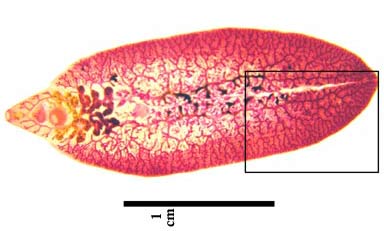40-90% of herbivores are infected with liver fluke
40-90% of herbivores live in the highlands are infected with large flukes . Master Nguyen Thi Giang Thanh, Department of Parasitology - National Institute of Veterinary Medicine said.
Liver fluke is a parasite that lives parasitic in herbivorous animals such as buffaloes, cows, sheep, goats . There are two types of liver fluke: fascioliasis and small liver fluke.
Fasciola gigantica in Vietnam has been developed. These liver flukes usually parasitize in the liver and bile ducts of herbivores.
Any kind of parasite goes through a life cycle, the life cycle of liver fluke is quite complicated. The liver fluke must go through an intermediate host, which is a snail, because tapeworm eggs are discharged through cattle manure, and when they meet the water environment, they hatch into larvae, the larvae will invade the intermediate host which is a snail in fresh water, In larval snails continue to develop into a state.

Larva Fasciola gigantica (Photo: med.cmu.ac.th)
Then the larvae escape to develop into the second larval state called Fasciola gigantica, which will cling to aquatic plants living in the water such as coriander, watercress, water spinach and vegetables needed. These types of vegetables, if washed off, are eaten by infected adults.
It should be noted that the intermediate snail is said to be a small snail with the small scientific name Lymnae in the field, not the snails we often eat. Moreover, this snail is an intermediate host for liver fluke to complete its life cycle. If we eat this snail, we will not be infected.
When these larvae are finished in the snail, they will release themselves from the snail and cling to the last aquatic plant of the liver fluke, which are buffaloes, cows, goats and people. After that, buffaloes, cows, goats and people eat vegetables, this grass infects the liver fluke, the larvae will complete the life cycle and develop into adult flukes.
The liver fluke larvae die at a temperature of 60-70 0 C, but if we eat raw vegetables, or eat hot pot again, the ceiling is not enough temperature 40-50 0 C, the liver fluke larvae still live.

Diagram of development cycle and life cycle of fascioliasis
1. Eggs from bile sugar are excreted in the faeces 2. Eggs fall into water environment 3. Larvae hatch from eggs 4. Intermediate snails transmit disease and larvae grow in snails 5. Larvae leave snail swimming in the water 6. Larvae in aquatic plants 7.8 .Herbivores or people who eat tapeworm larvae from aquatic plants or water, larvae into the stomach, pierce the wall of the gastrointestinal tract and abdomen and then penetrate the parasitic liver in the bile ducts.
Large liver fluke absorbs human nutrients through blood. For people, the diagnosis of fasciolosis by the method of finding eggs in the stool is difficult because they usually reside in the liver lobes. However, 2-10% of patients can find trematode traces of liver fluke.
As for liver flukes, cattle reside in the bile duct. Therefore, the method of finding eggs in feces is easy.
 Research on the development of liver fluke in the laboratory (Photo: TTO) Ruminants (buffaloes, cows, sheep .) infected with liver fluke are chronic. When infected, they rarely have symptoms of fever but manifest mainly as weight loss, weakness. Usually, animals infected with this disease at the stage of the migration of fascioliasis larvae often lead to rare gases that lead to a high risk of death.
Research on the development of liver fluke in the laboratory (Photo: TTO) Ruminants (buffaloes, cows, sheep .) infected with liver fluke are chronic. When infected, they rarely have symptoms of fever but manifest mainly as weight loss, weakness. Usually, animals infected with this disease at the stage of the migration of fascioliasis larvae often lead to rare gases that lead to a high risk of death.
Because these animals often eat grass in the fields, drinking pond water, the rate of liver fluke infection is very high. According to the National Institute of Veterinary Medicine survey over the years by the method of finding eggs in faeces, in the high mountainous areas, the proportion of herbivores infected with liver fluke accounts for 40-90%. This data shows that the prevalence of fasciolosis in herbivores is very high.
For people, to prevent fasciolosis, it is necessary to clean all kinds of aquatic vegetables (vegetables grown in water), eat cooked, boil.
For buffaloes, cows and goats . every year it is necessary to deworm worms. It is necessary to treat the faeces of these animals before use as basal fertilizer by pre-fertilizing before applying directly to the fields and vegetables to limit the growth of Fasciola gigantica larvae and cling to vegetables.
MYSTICAL GEM
- Eating habits that can make you not infected with fluke also have days of losing your liver
- Liver fluke and helminths appear in the south
- Eating raw fish is prone to liver cancer
- Parasitic species attach to the brain to control suicide ants
- Be wary of lung fluke
- Triclabendazole is effective for treatment of large liver fluke
- Korea: Detection of eggs in mummy liver 375 years old
- List of types of vegetables to help the fluke nest in the body
- Flukes invade the human brain
- The worms of the flukes of snail chewed away the human skin
- Who is at risk for hepatitis C?
- 10 things you may not know about the liver
 Green tea cleans teeth better than mouthwash?
Green tea cleans teeth better than mouthwash? Death kiss: This is why you should not let anyone kiss your baby's lips
Death kiss: This is why you should not let anyone kiss your baby's lips What is salmonellosis?
What is salmonellosis? Caution should be exercised when using aloe vera through eating and drinking
Caution should be exercised when using aloe vera through eating and drinking